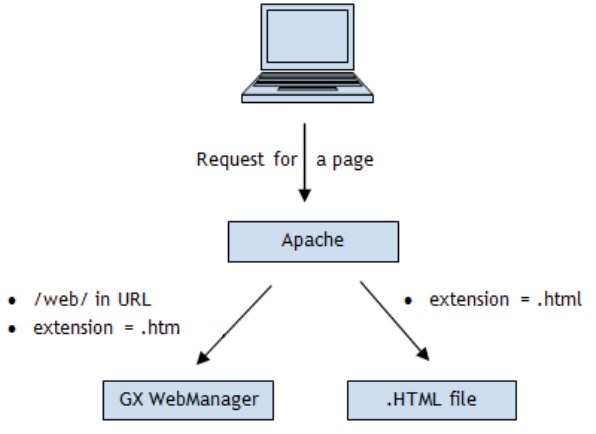In XperienCentral, you can save static versions of dynamic web pages to disk in a process known as "dumping". When you dump a page, a static HTML file containing the page's contents is created. The name of the file is the last part of the page's friendly URL. There is a speed advantage for pages that have been dumped because XperienCentral does not have to generate the content for a page when it is requested. You can set how often a static variant of a page should be saved to disk (for instance, once every two minutes). Often the home page of a website is dumped because it is the most visited page and therefore has the highest number of requests.
Pages that have been dumped with the extension ".html" are processed by the Apache web server instead of the Tomcat, WebSphere or JBoss server:
The extension given to the dumped HTML file should be different from the extension of the friendly URLs. Apache determines, based on a fixed pattern in the URL, where the page data should come from. By default, Apache transfers those URLs beginning with /web/ or ending with .htm directly to the application server. All other URLs are processed by Apache.
For performance reasons, XperienCentral will always use the static variant of a page if one exists. For example, a page with the title 'Economy' has the corresponding friendly URL "Economy.htm" and is also dumped to "Economy.html". When "Economy.html" is requested, XperienCentral will refer to "Economy.html" because it can be loaded faster. Requests to "Economy.htm" will also work but the response could be somewhat slower because the Tomcat server has to generate the page.
Dumping Pages to Static HTML Files
To dump a dynamic page in XperienCentral to a static HTML file, follow these steps:
- Navigate to Configuration > Server Configuration.
- Click the [Dumped content] tab.
- In the "Description" field, enter a description for the page you want to dump.
- Click [Apply]. Fields for specifying the name of the page and how often it should be dumped appear.
- In the "Relative URL" field, enter the friendly URL for the page, for example "/GX/Contact.htm". The relative URL that you specify must match the friendly URL listed under "URLs used by active versions".
- In the "Filename" field, specify the name of the HTML file.
- In the time field, enter the number of minutes and seconds after which XperienCentral will create a new static version of the page.
- Select "Yes" for "Active" if you want the page to be dumped every x minutes and x seconds as specified in the time field. Select "No" if you want to dump the page only one time.
- Click [Dump now]. The page will be dumped immediately. Thereafter, the page will be dumped every minutes and seconds that you specified if "Active" is set to "Yes". Now when the page is navigated to, the ".html" version is shown instead of the ".htm" version generated by the web server.
- To add another dumped file, enter its description in the "Add static file" field and click [Apply].
All files that you dump will be stored in the document root folder of the backend of your XperienCentral installation (<webmanager-root>\webmanager-webapps\webmanager-static-webapp\target\webmanager-static-webapp-<version>).
